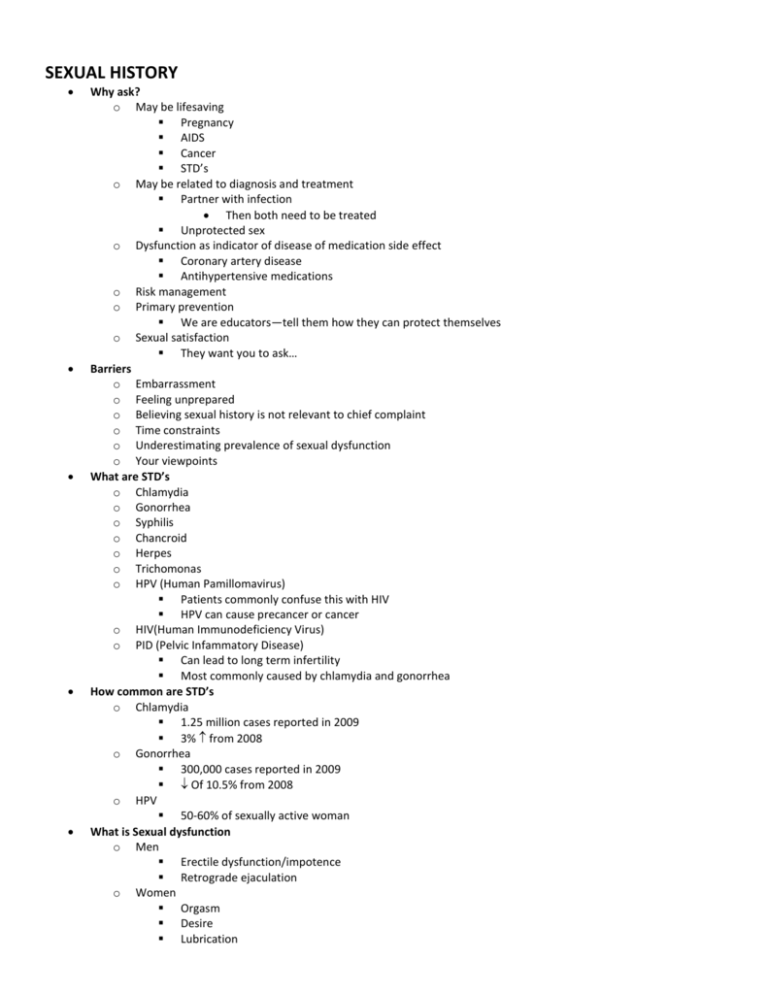
SEXUAL HISTORY
Why ask?
o May be lifesaving
Pregnancy
AIDS
Cancer
STD’s
o May be related to diagnosis and treatment
Partner with infection
Then both need to be treated
Unprotected sex
o Dysfunction as indicator of disease of medication side effect
Coronary artery disease
Antihypertensive medications
o Risk management
o Primary prevention
We are educators—tell them how they can protect themselves
o Sexual satisfaction
They want you to ask…
Barriers
o Embarrassment
o Feeling unprepared
o Believing sexual history is not relevant to chief complaint
o Time constraints
o Underestimating prevalence of sexual dysfunction
o Your viewpoints
What are STD’s
o Chlamydia
o Gonorrhea
o Syphilis
o Chancroid
o Herpes
o Trichomonas
o HPV (Human Pamillomavirus)
Patients commonly confuse this with HIV
HPV can cause precancer or cancer
o HIV(Human Immunodeficiency Virus)
o PID (Pelvic Infammatory Disease)
Can lead to long term infertility
Most commonly caused by chlamydia and gonorrhea
How common are STD’s
o Chlamydia
1.25 million cases reported in 2009
3% from 2008
o Gonorrhea
300,000 cases reported in 2009
Of 10.5% from 2008
o HPV
50-60% of sexually active woman
What is Sexual dysfunction
o Men
Erectile dysfunction/impotence
Retrograde ejaculation
o Women
Orgasm
Desire
Lubrication
Pain
Both
Emotional/quality of life
How common is sexual dysfunction?
o Men
20-30%
o Woman
30-40%
o Likely underestimated
Due to patient fear or physicians don’t ask
When to ask sexual history questions
o Relation symptoms
Burning urine, lump on genitals, etc.
Ask patient to expand or clarify
o Ob/gyn history
o Health maintenance
o Social history
Very common place to talk about this
o Review of systems
How To ask about Sexual history
o Use a transition
o Establish confidentiality
o Be clear with medical terminology
o Avoid judgment
o Do not assume
o Acknowledge uncomfortable feelings
o Eye contact, nodding
o Questionnaire
What to say…
o “In order to take excellent care of you, I need to ask you some personal questions”
o “I ask all of my patients these same questions”
o “I realize it feels awkward to talk about these things”
o DO NOT USE IMPROPER NAMES FOR ANATOMY OR FOR SEXUAL ACTIONS
DON’T SAY
Pooky, Pocketbook, Down Under, Tata, “Doing it”
OKAY TO SAY
The real parts
o Vagina
o Vulva (outside folds)
o Penis
o Private parts
Older patients find vagina and penis offensive
Generations
o Sex
Intercourse
o
The “PLISSIT” Model
o Permission (P)
For physicians to discuss sex with patient
For patient to discuss sexual concerns now and in future
To continue normal (nonharmful) sexual behaviors
Ask open ended questions, give patient permission to talk, reassure that feelings are acceptable
“Do you care if I ask you some questions”
“Do you have any concerns or questions about sexual functioning?”
“How satisfied with you sexual functioning are you”
“Is there anything about your sexual activity you would like to change”
o Limited information (LI)
Dispel myths
Give factual information
Sexual Response Cycle
Anatomy and Physiology
o The Parts
o
o
Effects of Illness
Effects of Medications
Life-cycle changes
o Encourage the use of condoms
Address what you can during the visit
Include education
Encourage patient to schedule follow up visits
Specific Suggestions (SS)
Suggestions directly related to the problem
Make small changes that may help
Manage comorbid conditions
Assess medications that may impact sexual function
Suggestions for safer sex
Familiarize yourself with resources
o Intensive Treatment (IT)
Provide highly individualized therapy for complex situations
Beyond providing basic information and suggestions most physicians will refer patient to qualified
specialists
Sex therapist
Couples counselors
Physical therapist
Endocrinologist
Urogynecologist
Domestic violence support group
Why should we do this
o Patients want to talk about it
o Patients are scared
o Patients have misconceptions
o Patients expose themselves to risk
Knowingly and unknowingly
o TO HELP PATIENTS
Objectives
To describe importance of taking a comprehensive and compassionate sexual history for wellness and addressing chief
complaint, identifying high-risk behaviors, and primary prevention
To examine one’s own attitudes toward sexuality and degree of comfort talking about sex with patients
To review general approach to taking sexual history through the use of “PLISSIT” model
To practice taking a sexual history with patient cases








